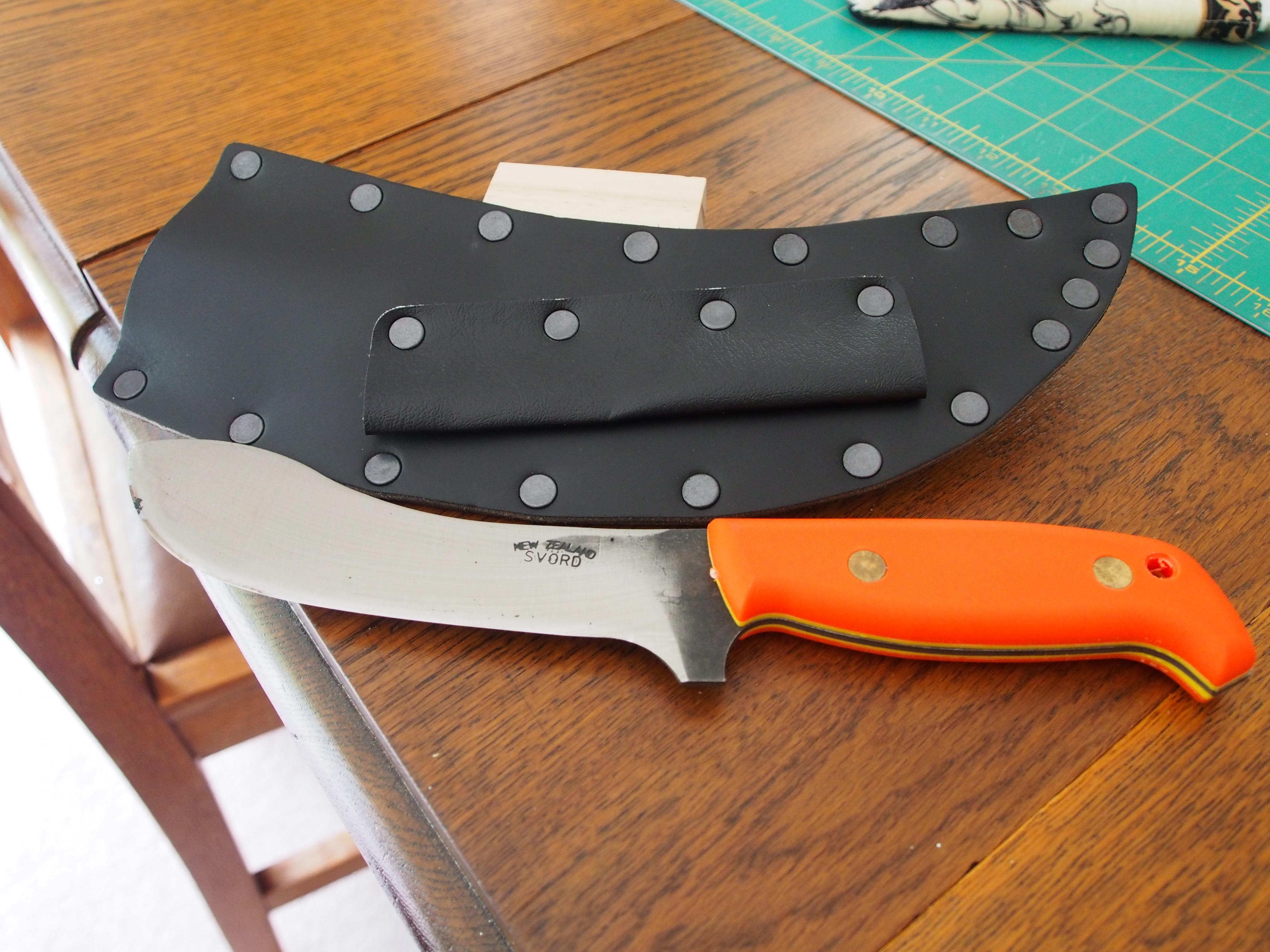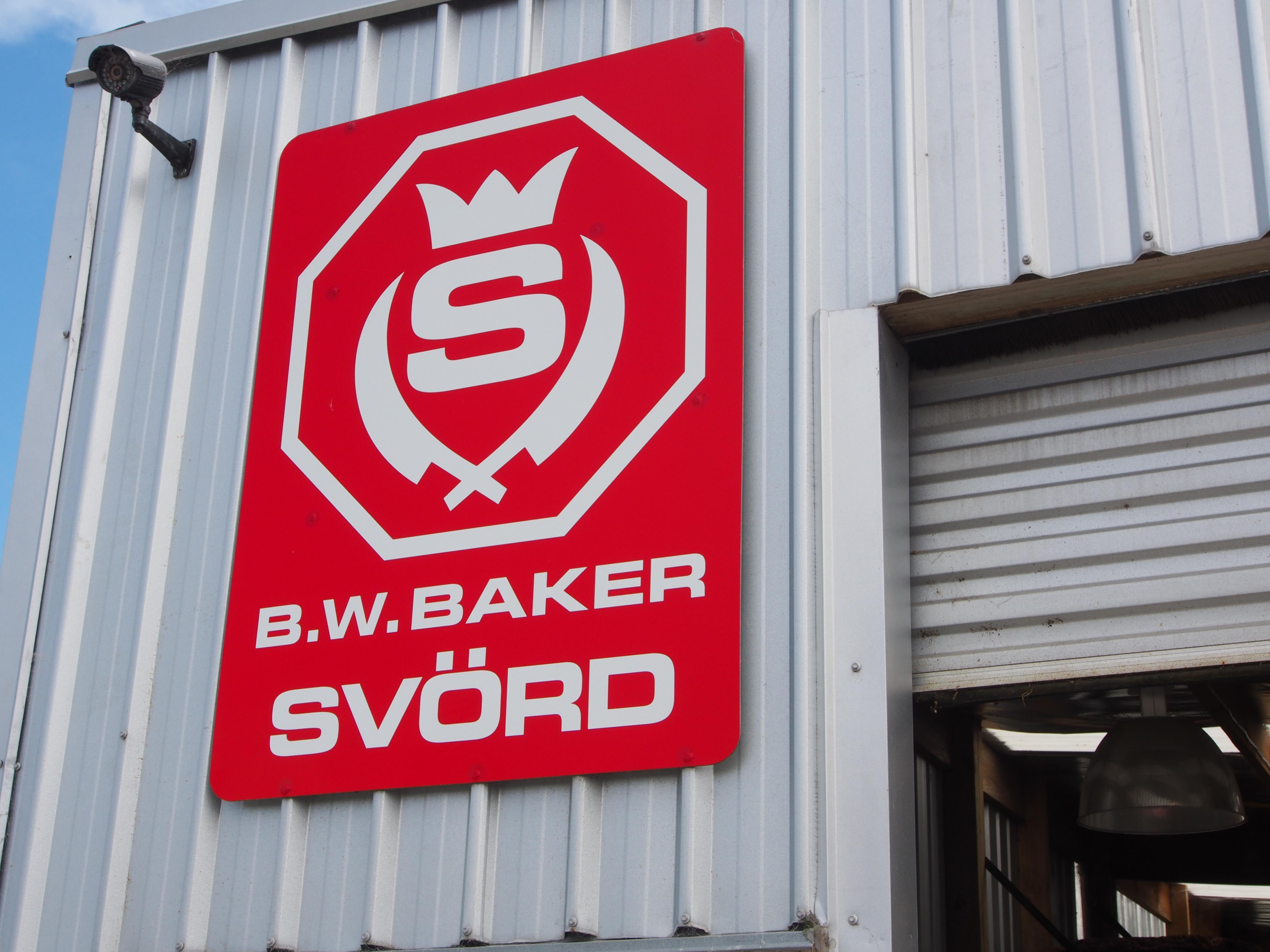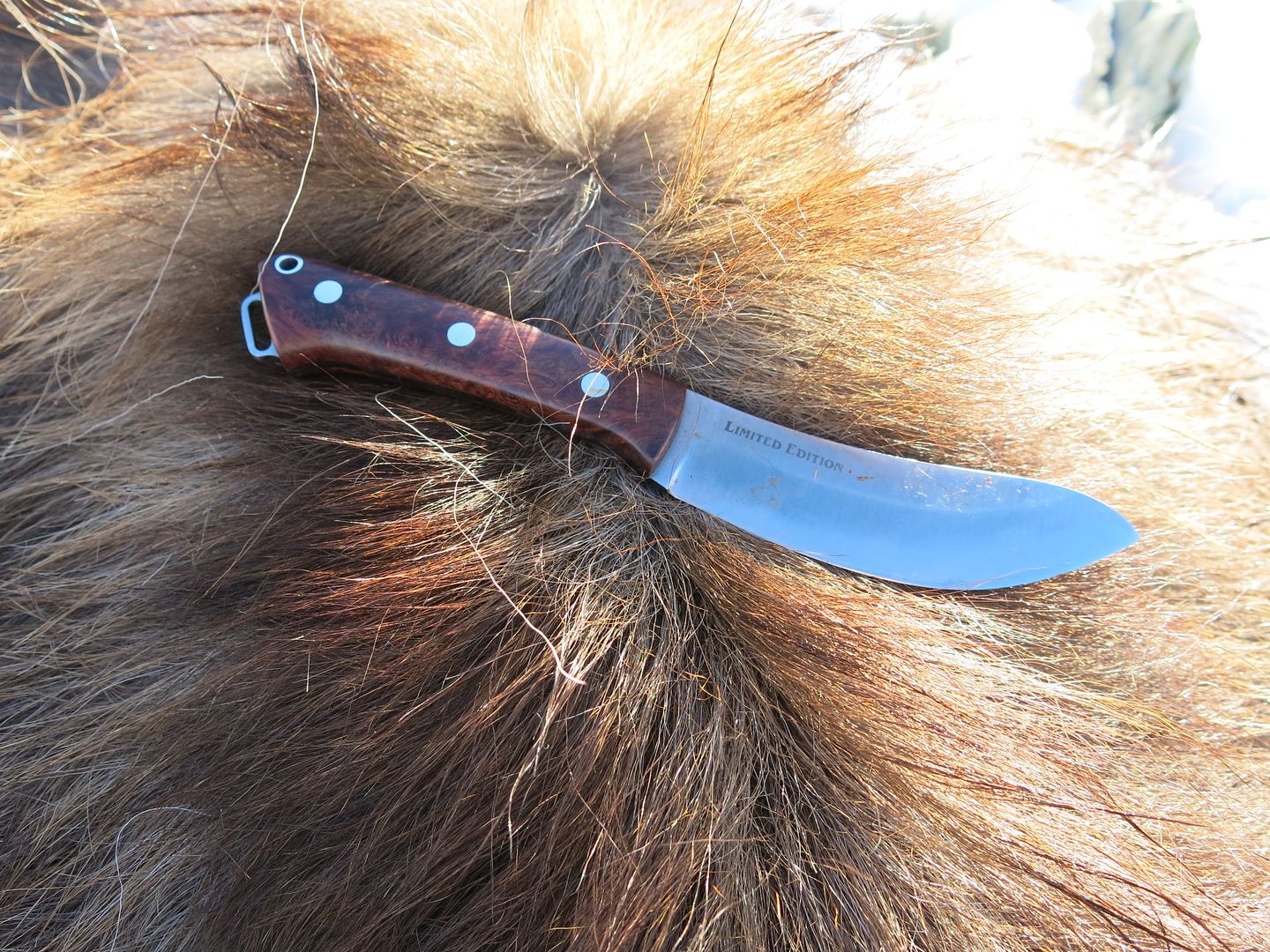As I have recently posted I visited the Svord Forge the other day and picked up a couple of new knives, the Peasant folder and this curved skinner:
Svord make several different curved skinning blades, they are based on the old butcher style of knives that you used to be able to see hanging up in every kiwi farmers shed and used for everything imaginable from chopping up a possum to feed the dogs, slicing off the twine on a bale of hay or whipping off some mountain oysters to feed the townies...
The top end one that Svord make is made from indestructible L6 tempered steel with a mahogany and brass handle, a convex grind and a simple leather sheath in a nice presentation box, the line up slowly comes down from that with L6 turning into 15N20 and the handle turning into plainer wood, the brass fittings disappearing and finally you get polypropylene handled ones with a simple leather sheath that is riveted together, as you can see above.
Ill go into the sheath first as thats what I swapped out straight away, there is nothing wrong with it, its thickish black leather, with a slot to thread your belt, the knifes goes in deep and is well retained and there is a vinyl steel loop attached to it, its functional but was not for me, and so I have sent my two new knives off to HGD to make a custom sheath to hold both knives in. Enough said.
The handle is polypropylene, in bright orange with yellow liners underneath, they four pieces are brass rivered to the full tang and whilst not as pretty as a wooden handle they should pretty much be impervious to the muck and blood that they will likely encounter; again the Sword finish was apparent and they needed a slight touch up with some sandpaper to make them comfortable to my hands, a 30 second fix, but a fix none the less (mind you this is an sub $80 knife, I was not expecting a Rolls Royce).
There are two models of curved skinner in this plastic handle range, and there appear to be two salient differences, both have 15N20 blades that have a very nice convex edge, both come in vast range of colour options (blue, green, black, orange, red, white or grey, yellow), both have blades that are 5 3/4 inches long, and both are fairly light (mine sans sheath is 160 gms), the difference is in one the guard is covered by the handle and the tang is not exposed, its a fully covered plastic handle, I am not sure how it is attached, maybe glue, maybe folded when hot, whereas my handle is bolted or riveted and the tang is exposed, meaning my handle may rust, but I like to see whats going on, the other difference is that the tip of my blade curves in a gentle arc to meet the back or spine of the blade, whereas in the other model the top is clipped off, this makes the tip sharper, but is not as graceful or as useful in my mind as you could accidentally cut into something that you would rather not when reaching into the carcass.
Now my skinning is not really to preserve the hide, although if I ever get a nice hide I may want to keep it, really I am just trying to get the meat away from the guts and bits I don't want and the skin is there to keep the dirt and the files off until it can be properly butchered and placed into nice little plastic baggies in the freezer, and this is definitely the longest blade I would want to do that with, normally I would be looking at a 4 inch blade but I had always wanted to have my own curved skinner, and so now I do.
Since getting it and sharpening it, then sending it off for a new sheath I have not had a chance to put it to work upon a hide but I did get a chance to test it out on some meat, and the result was startling. Maybe its due to the curve or maybe its due to the convex edge and the thin steel but this thing sliced through meat better than my kitchen knives, and I keep those knives razor sharp!
It seemed to cut deeper and with less effort than the length of blade would account for; this sounds cryptic but if I apply pressure X and cut for length Y I should get to the end of my cut at the same time as I hit the board, this way I maximise my cut and do not needlessly blunt the blade by cutting into the wooden board beneath the meat, in this case I was chopping through the board sooner than normal, meaning that Y was shorter as I was already though the meat before the end of the stroke. The meat just seemed to open up, almost peel away, from the blade with almost no effort, this should be good in the field, less so in the kitchen, but then this is a field knife and not a kitchen knife, result: bloody good, end of kitchen test. Now I need to wait to get the knife back to try it in the field.
So I am happy with both my new knives, neither were perfect out of the box, but both became acceptable with very little effort, and cost very little money, did not cost me any postage, are good kiwi products and are eminently replaceable if I lose them, they just need a little love and a little oil on the blade to keep them from rusting, being high carbon steel.
Shelley
Welcome guest, is this your first visit? Create Account now to join.
Welcome to the NZ Hunting and Shooting Forums.
Search Forums
User Tag List
+ Reply to Thread
Results 1 to 15 of 32
Thread: Svord Curved Skinner
-
24-11-2014, 01:20 PM #1Member

- Join Date
- Aug 2014
- Location
- Auckland
- Posts
- 719
Svord Curved Skinner
-
-
24-11-2014, 02:14 PM #2
Nice @Shelly.. Might need to invest in one of those...
-
24-11-2014, 05:06 PM #3Bah, humbug !


- Join Date
- Nov 2013
- Location
- Auckland, until I can escape south....to Southland.
- Posts
- 1,699
Love my 3 Svords, just hate to think how long ago I bought the first one !
-
24-11-2014, 09:17 PM #4
Yes the knives are great, sheaths.....well i could be a bit one sided but i will say this. They have gone backwards. Was a bit shocked when i got my latest order in and all sheaths were like this. Good for me though i guess??
-
24-11-2014, 09:50 PM #5
-
25-11-2014, 06:47 AM #6Member

- Join Date
- Jun 2012
- Location
- lower hutt
- Posts
- 1,049
Did that sheath in the top pic really come from svord? Cause that is sheeeit
-
25-11-2014, 06:53 AM #7Member

- Join Date
- Dec 2011
- Location
- NI
- Posts
- 13,547
-
25-11-2014, 07:00 AM #8
-
25-11-2014, 07:01 AM #9
-
25-11-2014, 07:06 AM #10
-
25-11-2014, 09:16 AM #11Member

- Join Date
- Aug 2014
- Location
- Auckland
- Posts
- 719
Yup, I understand to keep costs down Svord have abandoned their old practice of getting sheaths stitched outside of the factory and instead have changed their dies to enable the sheaths to be riveted in house, they are also looking at abandoning leather and going to a vinyl stuff that is impervious to the elements, supposedly it's very heavy duty, will last forever. Not for me, hence I go to HGD for my sheaths...
So Tahr, what did that little number cost you then?
-
25-11-2014, 09:34 AM #12Member

- Join Date
- Dec 2011
- Location
- NI
- Posts
- 13,547
-
25-11-2014, 05:42 PM #13
-
25-11-2014, 05:49 PM #14
-
25-11-2014, 06:55 PM #15Member

- Join Date
- Dec 2011
- Location
- NI
- Posts
- 13,547
Similar Threads
-
Red Dot v Skinner Sights
By muzz333 in forum Firearms, Optics and AccessoriesReplies: 13Last Post: 15-02-2014, 07:44 AM -
Skinner Sights ....Any Good?
By P38 in forum Firearms, Optics and AccessoriesReplies: 7Last Post: 25-10-2013, 12:09 PM -
The ten minute deer skinner
By rob270 in forum HuntingReplies: 14Last Post: 30-08-2013, 12:35 PM -
Filleting knife straight or curved?
By Shooter in forum FishingReplies: 8Last Post: 28-02-2012, 04:36 PM
Tags for this Thread
Welcome to NZ Hunting and Shooting Forums! We see you're new here, or arn't logged in. Create an account, and Login for full access including our FREE BUY and SELL section Register NOW!!





 13Likes
13Likes LinkBack URL
LinkBack URL About LinkBacks
About LinkBacks





 Reply With Quote
Reply With Quote

 you must be quite good with your hands then...for a farmer.
you must be quite good with your hands then...for a farmer. 



Bookmarks